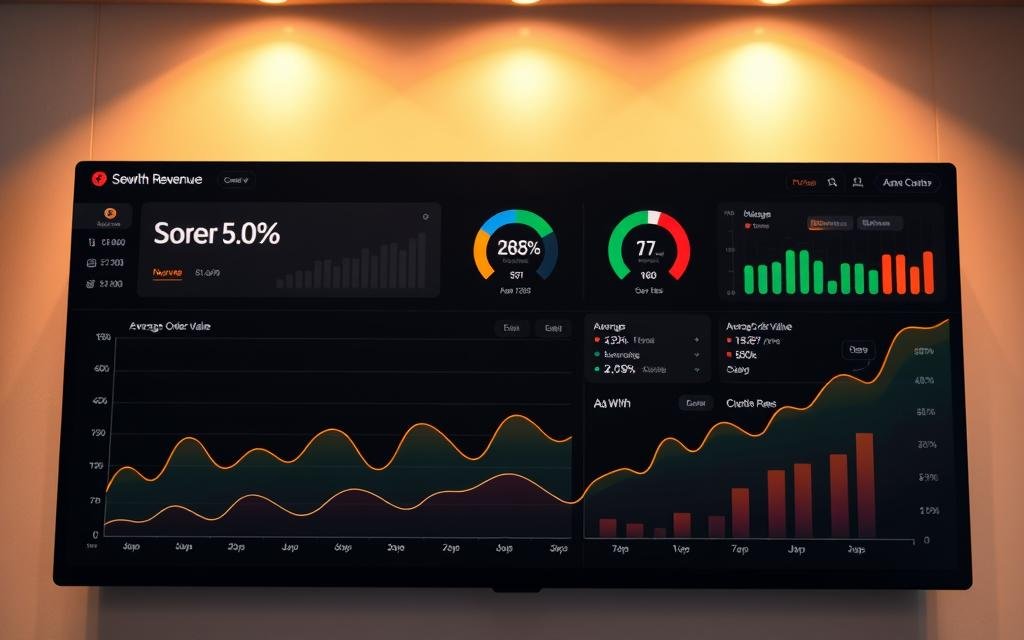Did you know 93% of e-commerce brands miss out on key growth strategies? The e-commerce market is set to hit $30 trillion by 2026. This makes it more important than ever to boost revenue in e-commerce.
I want to share expert tips and strategies to help online business owners reach their revenue goals. We’ll cover everything from understanding key performance indicators to using data analytics and improving user experience. This article will guide you on how to increase revenue in a sustainable way.
Many shoppers seek personalized experiences and new ways to find products. It’s essential to adapt and succeed in this changing market. I’m excited to share strategies that can really help your e-commerce business grow.
Key Takeaways
- 93% of e-commerce brands overlook essential growth strategies.
- The e-commerce market is on track to hit $30 trillion by 2026.
- Personalization can increase conversion rates significantly.
- Understanding and tracking revenue metrics is vital for success.
- Enhancing user experience can lead to a substantial boost in sales.
- Utilizing social media effectively is key for expanding online reach.
Understanding Revenue Goals in E-commerce
Setting e-commerce revenue targets is key to a business’s financial success. These targets guide how to use resources wisely. Understanding revenue goals is vital for growth and making profits.
What Are Revenue Goals?
Revenue goals are financial targets for a business to hit within a certain time. They can be daily, monthly, or yearly sales. Having clear revenue goals helps measure success and stay on track for growth.
Importance of Setting Revenue Goals
Revenue goals are very important. They push teams to do their best and guide marketing plans. Setting goals makes everyone accountable and helps track performance better.
This leads to smarter decisions. Goals also help spot where to improve and celebrate wins.
Key Performance Indicators for E-commerce
In the fast-paced world of e-commerce, knowing and using Key Performance Indicators (KPIs) is key. They help us see how well a business is doing financially and how it’s growing. By looking at these metrics, we can make smart choices for our business.
Identifying Revenue Metrics
To predict e-commerce revenue, I focus on important metrics. These include:
- Average Order Value (AOV) – Shows the average amount spent by customers, which is vital for growth.
- Customer Acquisition Cost (CAC) – Tells us how much it costs to get a new customer, affecting profits.
- Conversion Rate – Shows how many visitors actually buy something, showing how well our marketing works.
Knowing these metrics helps us see if we’re doing well. It also helps us plan our strategies to meet our financial goals.
Tracking and Measuring Success
Tracking KPIs is a detailed process that helps us see how we’re doing over time. Tools like Google Analytics, Shopify reports, and CRM software help us collect and analyze data. By watching these trends, we can change our plans to better meet customer needs and sales patterns.
The table below shows how these metrics can be tracked over a few months:
| Month | Average Order Value | Customer Acquisition Cost | Conversion Rate |
|---|---|---|---|
| January | $75 | $20 | 4.5% |
| February | $80 | $18 | 5.2% |
| March | $90 | $19 | 6.0% |
By looking at these metrics, we can spot trends. This helps us make better plans for the future. It leads to more success for our business.
Creating a Revenue Growth Strategy
Creating a good revenue growth strategy is key for a successful e-commerce business. It acts as a guide for increasing sales and profits over time. To do this, I need to set both short-term and long-term plans that match my big goals.
Setting Short-term and Long-term Goals
Short-term goals are about quick wins, like hitting sales targets or running promotions. They motivate my team to reach specific numbers. On the other hand, long-term plans aim for lasting growth. They consider expanding the market, adding new products, and improving the brand.
By balancing these, my strategy stays fresh and true to my vision.
Adapting to Market Changes
Being flexible is essential in e-commerce. Market trends and customer wants can change fast. By keeping an eye on these shifts, I can tweak my strategy as needed.
This adaptability helps me meet customer needs and stay ahead of the competition. For more tips, I look at how to make money with e-commerce. Being open to change supports both short-term wins and long-term success.
Utilizing Data Analytics for Revenue Goals
In today’s competitive e-commerce world, using data analytics is key to reaching revenue goals. By studying customer behavior, I gain insights into what they like and how they shop. This helps me improve marketing and make shopping better for customers.
Analyzing Customer Behavior
Knowing how customers behave is vital for e-commerce success. I look at various metrics to see how visitors use my site. This lets me know which products are popular and where customers might leave the buying process.
This info helps me make my marketing more relevant to what customers want.
Leveraging Data for Decision Making
Good decisions come from the data on how customers interact with my site. Using data analytics, I can see important metrics like conversion rates. This way, I can adjust my marketing to better reach my audience.
Analytics give me solid data to make choices that boost revenue.
Tools and Software to Consider
There are many e-commerce analytics tools to help with this. For example, I find useful insights with different analytics platforms. These tools help me track my performance and find ways to increase sales.
By using these tools, I stay up-to-date with the changing e-commerce world.
Enhancing Product Pages to Boost Revenue
Optimizing product pages is key to driving sales and improving user experience. By focusing on high-quality images and compelling descriptions, I can boost e-commerce revenue. Effective strategies on product pages attract visitors and turn them into happy customers.
Importance of High-Quality Images
High-quality images are vital in e-commerce. They are the first thing customers see and can make them stay or leave. Clear, vibrant images help buyers see the product details, building trust and letting them imagine the item in their lives.
Using multiple angles and close-ups of products makes the offer more appealing. This increases the chance of a purchase.
Writing Compelling Product Descriptions
Compelling product descriptions highlight what makes an item special. They tell a story that connects with the customer. By focusing on benefits and how the product solves problems, they stand out.
I use persuasive language to draw in customers while keeping descriptions informative. This is key to boosting e-commerce revenue.
A/B Testing for Optimization
A/B testing is a smart way to optimize product pages. It involves creating two versions of a page to see which one customers prefer. This can include different images, descriptions, or calls to action.
By analyzing data from these tests, I can refine the page layout. This increases conversion rates and boosts revenue. The insights from A/B testing help me understand what customers like.
Developing a Strong Online Marketing Plan
An impactful online marketing plan is key for boosting brand awareness and reaching revenue goals. It involves using effective e-commerce marketing strategies to improve search engine rankings. This helps increase online visibility and make products stand out in search results.
SEO Strategies for Increased Visibility
Search Engine Optimization (SEO) is a strong way to drive organic traffic. By using keywords, creating informative blog content, and optimizing on-page elements, I can boost rankings. Meta descriptions are also important. They help attract clicks from search engine results pages.
Having a mobile-friendly design is also essential. More and more people shop on their mobile devices. Focusing on these SEO strategies can attract visitors and drive sales.
Pay-Per-Click Advertising
PPC campaigns are another effective way to get immediate traffic. By targeting ads, I reach people who are more likely to buy my products. Using platforms like Google Ads helps me create ads that match what my customers are interested in.
Using engaging visuals and clear calls to action in ads can lead to more website visits. This can result in higher conversion rates. Combining PPC with SEO strategies ensures a steady flow of buyers.
Building Customer Loyalty and Retention
Having a loyal customer base is key to keeping your e-commerce business growing. This loyalty means more repeat buys, less spent on marketing, and more people talking about your brand. All these help your business thrive.
Benefits of a Loyal Customer Base
Keeping customers loyal is a big win. They tend to buy more often, which makes your income more stable. Plus, they often tell others about their good experiences, bringing in new customers without extra marketing. This can save you a lot of money.
Strategies for Improving Customer Experience
To make customers happier, I use a few key strategies. Making things personal by tailoring offers to what they like can really engage them. Quick and reliable shipping and fast customer service also make a big difference. A good returns policy builds trust and keeps customers coming back.
Implementing Reward Programs
Reward programs are a great way to keep customers coming back. By giving them discounts, points, or special deals, I show them they’re valued. Studies show that using these programs can increase both customer loyalty and sales. It’s a smart way to keep customers for the long haul. For more ideas on loyalty programs, check out this resource.
| Benefit | Impact on Revenue | Customer Engagement |
|---|---|---|
| Increased Repeat Purchases | Higher revenue predictability | Enhanced customer trust |
| Reduced Marketing Costs | Lower acquisition expenses | Positive word-of-mouth |
| Greater Customer Advocacy | Attract new customers | Improved brand reputation |
Using Social Media to Drive E-commerce Revenue
Social media marketing for e-commerce has changed how businesses connect with people. Platforms like Facebook, Instagram, and Pinterest are key for sales. Choosing the right platforms boosts engagement and sales.
Choosing the Right Platforms
Knowing where my audience hangs out is key. Each platform has its own strengths. For example, Instagram is great for brands with visual products.
By focusing on the right platforms, I can build a more engaged community. This leads to more sales.
Creating Engaging Content
Creating content that grabs attention is vital. I use stories, videos, and interactive posts to get people talking. Content that hits the mark boosts engagement and sales.
Using user-generated content and influencer marketing adds authenticity. It shows product benefits and builds trust. Contests and giveaways can also increase interaction and drive traffic to my site.
Advertising on social media helps drive direct sales. Setting clear goals and measuring ROI is essential. This way, I can adjust my strategy for better results.
For more on social media and e-commerce sales, check out this link.
Exploring Influencer Marketing Opportunities
Influencer marketing is key for boosting brand visibility in e-commerce. By teaming up with the right influencers, businesses can tap into their influence. It’s all about choosing influencers who match their target audience.
Identifying the Right Influencers
Finding influencers who share your brand’s values is essential. This ensures real and engaging collaborations. I look at their audience, engagement, and reputation to find the best fit.
Building Authentic Partnerships
Creating real partnerships with influencers means more than just promoting products. It’s about sharing stories and building relationships. When influencers share their true experiences, it makes their endorsements more believable.
Expanding into New Market Segments
Expanding into new market segments is a great way for businesses to grow. Good market research is key to entering new e-commerce markets. It helps me understand what customers want and who my competitors are.
I look closely at different areas or groups of people. This way, I know how to succeed when I enter a new market.
Researching Possible Markets
Getting to know possible markets takes a lot of work. I collect data on trends, what customers like, and who else is out there. This helps me plan how to grow.
I also do surveys and check social media to see what people are interested in. My aim is to find markets that need what I offer.
Adjusting Strategies for New Audiences
After finding the right markets, I need to adjust my plans. It’s important to change my products, ads, and prices to fit what people want. This way, I can make more money and reduce risks.
Creating content for each area and using local marketing helps a lot. It makes it easier to connect with new customers and build my brand.
The Role of Customer Feedback in Revenue Goals
Understanding the importance of customer feedback is key to setting business goals. By using different ways to get feedback, companies can find areas to get better. This helps them make their products and services better, leading to more sales. E-commerce surveys are a great way to get this feedback, making it easier to understand what customers think.
Collecting and Analyzing Feedback
Feedback can come from many places, like surveys, product reviews, and social media. Each one gives a unique view of how customers feel. By looking at this feedback, companies can spot trends and what customers like or dislike.
Implementing Changes Based on Insights
Using feedback to make things better is just the first step. Making changes based on what customers say shows they are valued. When customers see their opinions make a difference, they feel closer to the brand. This not only keeps customers coming back but also helps the company grow.
Monitoring and Adjusting Your Revenue Goals
In the fast-changing world of e-commerce, keeping an eye on your revenue goals is key. Regularly checking how you’re doing against your key performance indicators (KPIs) helps you see if you’re on track. This lets you know if it’s time to change your strategy.
Staying flexible is vital in this market. I’ve seen how changes in what customers want, market trends, and competition can affect your business. Making smart changes based on these insights helps your business grow and stay strong.
By watching your revenue goals closely and making smart changes, your business gets stronger. I urge other e-commerce folks to make regular reviews a part of their routine. This way, they can stay on top of their game and make a big impact in their markets.



